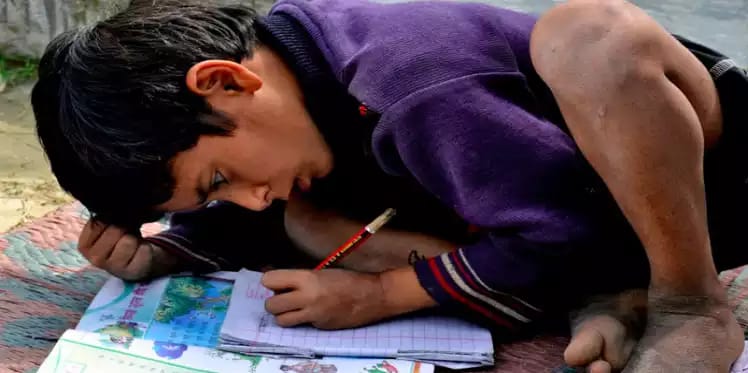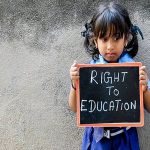The Right to Education Act 2009, also known as the RTE Act 2009, was enacted by the Parliament of India on 4 August 2009. It describes modalities of the importance of free and compulsory education for children aged between 6-14 years in India under Article 21 (A) of the Constitution of India. This act came into effect on 1 April 2010 and made India one of the 135 countries to have made education a fundamental right for every child. It prescribes minimum norms for elementary schools, prohibits unrecognised schools from practice and advocates against donation fees and interviews of children at the time of admission. The Right to Education Act keeps a check on all neighbourhoods through regular surveys and identifies children who are eligible for receiving education but do not have the means to.
Educational challenges have been prevalent at both the centre and states for many years in India. The Right to Education Act 2009 maps out roles and responsibilities for the centre, state and all local bodies to rectify gaps in their education system in order to enhance the quality of education in the country.
1. Compulsory and free education for all
It is obligatory for the Government to provide free and compulsory elementary education to each and every child, in a neighbourhood school within 1 km, up to class 8 in India. No child is liable to pay fees or any other charges that may prevent him or her from pursuing and completing elementary education. Free education also includes the provisions of textbooks, uniforms, stationery items and special educational material for children with disabilities in order to reduce the burden of school expenses.
In 2013, Oxfam India critiqued Right to Education (RTE) Forum’s Stocktaking Report 2013, which evaluated the three year progress of the Right to Education Act since its enactment in 2009. While considerable progress was made on aspects like primary level enrolment rates, launching new schools, appointment of new teachers and ensuring safe drinking water and toilet facilities for children, the overall delivery did not live up to the expectations. Oxfam India in its policy brief recommended five solutions to rectify gaps and loopholes in order to enhance implementation and effectiveness of the Right to Education Act 2009.
Click here to read more: https://www.oxfamindia.org/policybrief/right-free-and-compulsory-education
2. The benchmark mandate
The Right to Education Act lays down norms and standards relating to Pupil-Teacher-Ratios (number of children per teacher), classrooms, separate toilets for girls and boys, drinking water facility, number of school-working days, working hours of teachers, etc. Each and every elementary school (Primary school + Middle School) in India has to comply with these set of norms to maintain a minimum standard set by the Right to Education Act.
Click here to read more: https://www.oxfamindia.org/blog/mystery-out-school-children-indian-education-system
3. Special provisions for special cases
The Right to Education Act mandates that an out of school child should be admitted to an age appropriate class and provided with special training to enable the child to come up to age appropriate learning level.
4. Quantity and quality of teachers
The Right to Education Act provides for rational deployment of teachers by ensuring that the specified Pupil-Teacher-Ratio is maintained in every school with no urban-rural imbalance whatsoever. It also mandates appointing appropriately trained teachers i.e. teachers with the requisite entry and academic qualifications.
In 2018, Oxfam India analysed the nine year progress of the Right to Education Act since its enactment in 2009. The observations highlighted significant lack of allocation of resources to education in general and elementary schools. This was far from satisfactory and needed immediate amends in order to improve overall learning outcomes of children. Oxfam India in its policy brief recommended seven ways to address this problem.
Click here to read more: https://www.oxfamindia.org/policybrief/public-provisioning-elementary-education-india-some-issues-around-public-financing
https://www.oxfamindia.org/blog/quality-education-unfinished-agenda-rte-act
https://www.oxfamindia.org/blog/teachers-needed-government-schools-are-falling-behind-due-lack-funds
5. Zero tolerance against discrimination and harassment
The Right to Education Act 2009 prohibits all kinds of physical punishment and mental harassment, discrimination based on gender, caste, class and religion, screening procedures for admission of children capitation fee, private tuition centres, and functioning of unrecognised schools.
The Right to Education (RTE) Forum’s Stocktaking Report 2014 suggested that across the country, less than 10 percent schools comply with all of the Right to Education Act norms and standards. While enactment of the Right to Education Act 2009 triggered significant improvements, concerns regarding privatisation of education remains. Educational inequalities have held a strong ground in India for many years. While the Right to Education Act offers the first step towards an inclusive educational system in India, effective implementation of the same still remains to be a challenge. Oxfam India in its policy brief suggested several ways to improve implementation of the Right to Education Act 2009.
Click here to read more: https://www.oxfamindia.org/policybrief/rte-act-claiming-education-every-child
6. Ensuring all round development of children
The Right to Education Act 2009 provides for development of curriculum, which would ensure the all-round development of every child. Build a child’s knowledge, human potential and talent.
Oxfam India is supporting Samarth Foundation, since 2013, in 24 schools in 19 Gram Panchayats in two blocks Kurara and Maudaha of Hamirpur district. Together, they aimed at bringing back children to schools by building a child-friendly environment in schools, and engaging the community by strengthening School Management Committees (as mandated under the RTE Act). During this period, SMCs appointed 45 new teachers; a few of them were felicitated for their pedagogic intervention.
Click here to know more: https://www.oxfamindia.org/oxfam-in-action/community-engagement-improve-implementation-rte-act-uttar-pradesh
7. Improving learning outcomes to minimise detention
The Right to Education Act mandates that no child can be held back or expelled from school till Class 8. To improve performances of children in schools, the Right to Education Act introduced the Continuous Comprehensive Evaluation (CCE) system in 2009 to ensure grade appropriate learning outcomes in schools. Another reason why this system was initiated was to evaluate every aspect of the child during their time in school so that gaps could be identified and worked on well in time.
Click here to read more: https://www.oxfamindia.org/oxfam-in-action/strengthening-education-quality-uttar-pradesh
8. Monitoring compliance of RTE norms
School Management Committees (SMCs) play a crucial role in strengthening participatory democracy and governance in elementary education. All schools covered under the Right to Education Act 2009 are obligated to constitute a School Management Committee comprising of a head teacher, local elected representative, parents, community members etc. The committees have been empowered to monitor the functioning of schools and to prepare school development plan.
Since 2015, Lokmitra and Oxfam India have been working in 30 government schools in three blocks — Rahi, Salon and Raebareli Municipality of Raebareli district, Uttar Pradesh. They have been working towards ensuring proper implementation of the RTE Act 2009, increasing student retention, and increased community participation in monitoring and management of schools. Lokmitra’s innovative participatory pedagogy methods and involvement of parents through SMCs at the block and district level have shown positive results. Regular trainings and meetings have empowered these SMCs to monitor and manage the schools better and advocate for its improvement.
Click here to read more: https://www.oxfamindia.org/oxfam-in-action/strengthening-education-quality-uttar-pradesh
9. Right to Education Act is justiciable
The Right to Education Act is justiciable and is backed by a Grievance Redressal (GR) mechanism that allows people to take action against non-compliance of provisions of the Right to Education Act 2009.
To ensure all schools follow this mandate, Oxfam India in collaboration with JOSH filed a complaint at the Central Information Commission (CIC) in 2011 evoking Section 4 of the Right to Information Act (RTI Act) 2005. Section 4 of the RTI Act is a proactive disclosure section mandating all public authorities to share information with citizens about their functioning. Since schools are public authorities, compliance to Section 4 was demanded.
Click here to read more: https://www.oxfamindia.org/policybrief/community-based-monitoring-and-grievance-redressal-schools-delhi
10. Creating inclusive spaces for all
The Right to Education Act 2009 mandates for all private schools to reserve 25 per cent of their seats for children belonging to socially disadvantaged and economically weaker sections. This provision of the Act is aimed at boosting social inclusion to provide for a more just and equal nation.
Click here to read more: https://www.oxfamindia.org/featuredstories/indias-missing-millions-out-school-children-case-reality-not-living-estimation
Why should we support Education for Girls?
As per UNICEF data records the adjusted primary net enrolment rate for the year 2014-15 was 91 and 90 for girls. About 31 million girls across the globe do not have access to primary education. Equality in the sexes in terms of their access to education and health has an intrinsic value in its own light. In India, the total enrolment in primary schools in India during the year 2014-15 was 1, 97,666 where only 95,556 of them were girls. Young girls in India are often forced to or voluntarily drop out of schools since they either have to look after their younger siblings or have to contribute to the household chores. Centres opened by Oxfam India in different areas in priority and priority plus states help both school going and non-school going kids to be at par with the school curriculum. The non-school going kids are prepared so that they are able to appear for the admission tests in schools and get enrolled in an age-appropriate class. A child who was unable to read or write is also taught in a manner that suits his interests leading to maximum learning. If a child fails or is unable to clear her tests or exams she becomes demotivated to continue her studies. Community organizations help these children to complete their schooling through registrations with NIOS. These community-based organizations also offer various vocational courses like English speaking, stitching, BPO service calling for the girls to be able to be economically dependent. If educated, girls can contribute equally to economic development thus reducing gender imbalances in terms of education which enhances human capital formation. An extensive study on the human capital theory suggests that education plays a major role in increasing the productivity of the economy by increasing the factor output per worker. Education and human resource development are at the center of long-term economic developmental plans. The lack of safety and security also leads to girls discontinuing school. Morning school for girl students is followed by afternoon school for boys. Senior students often complain that the boys tease and follow them home at the time when their school is over. Due to they are earlier complains police patrolling had increased when the girls came out of school however as soon as the number of policemen decreased he boys continued to harass them. Many girls had dropped out of school because their parents believed that it was no longer safe to send their daughters to school. Despite continuous complaints to both the police as well as the SMC members the problem still persists. The NCPCR has introduced new guidelines for the health, hygiene, safety, and security of students both in private and government schools. The new guidelines point out that girls must be taught about menstrual hygiene and be supported so that they do not miss school. They also state that schools should ensure zero tolerance on any matter related to sexual abuse of a child and stringent action shall be taken against the perpetrators of law.
An educated girl also understands the high importance of education for her future generations and is able to create a better lifestyle and provide better healthcare to her children. Apart from this, educating a girl child will directly reduce infant and maternal mortality rates, child marriages, domestic and sexual violence in families. An educated girl is also more likely to participate in political discussions, meetings, and decision-making leading to the formation of a more representative and democratic government.
Article Compiled by – Mr. Vedansh Anand
Legal Researcher
Source of the Article is – OXFAM INDIA
Read the entire paper here –


